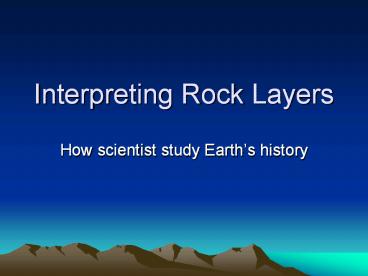Interpreting Rock Layers - PowerPoint PPT Presentation
1 / 15
Title:
Interpreting Rock Layers
Description:
Interpreting Rock Layers How scientist study Earth s history There are two types of time dating Geologists use relative dating to figure out if a rock is older or ... – PowerPoint PPT presentation
Number of Views:149
Avg rating:3.0/5.0
Title: Interpreting Rock Layers
1
Interpreting Rock Layers
- How scientist study Earths history
2
Rock layers can be seen on this exposed cliff.
Each layer represents a certain span of time.
What techniques can scientists use to estimate
the age of the rock?
3
There are two types of time dating
- Geologists use relative dating to figure out if a
rock is older or younger than another rock.
- In rock that is not disturbed (moved around by
tectonic forces) - The older rocks are on bottom.
- The younger rocks are on top. (law of
superposition) - Just like laundry in a laundry basket
4
Fossils also help.Looking at animals present in
the layers helps scientists estimate age. Tell
me how.
Index fossil can also be used to show the
approximate ages of rock. Fossils in different
rock layers can be compared to determine one rock
layers age in relation to anothers
5
(No Transcript)
6
Problems
- Rock layers are not undisturbed. Earthquakes,
faults, flooding, erosion, volcanic activity all
change the landscape (some quickly and some
slowly) - Unconformity a gap in the rock sequence that
happens because - agents of erosion (water, wind, glaciers) move
layers or parts of layers away - or
- because no deposition occurs in that area.
- Deposition does not evenly distribute sediments
(higher areas may not get as much as lower etc..) - or
- Earthquakes/plate movement has caused ground to
be uplifted - Igneous intrusions and extrusions can also change
how the layers look.
7
Intrusions must be younger than the rock they
pass through. You cannot go through something
unless it was there first!
8
Faults cause layers to shift up or down
9
Erosion can cause layers to disappear.
10
But What If You Want to Know the Exact Age?
- Geologists often also need to know the exact age
of a rock or fossil. - Finding the exact age of an object is called
absolute dating. - Remember absolute means exact or definite.
O
11
Parents and Daughters
- Scientists can learn the age of a rock by
counting the number of parent and daughter atoms
and comparing it.
- Radioactive dating
- Radioactive dating uses the half-life of atoms
to figure out the age of the rock layers the
atoms are in. - Determines Absolute Age
12
Half-Lives of Two Atoms
- Potassium-40 has a half-life of 1.3 billion
years. It can be used to date rocks older than
100,000 years. - Uranium-238 has a half life of 4.5 billion years.
It can be used to date rocks older than 10
million years.
- The half-life of carbon-14 is known to be 5720
years. Why do you think it is a good element to
use to date fossils and some rock?
Shorter half life means more accurate age
13
Rock Layers Activity
14
(No Transcript)
15
Depict the following subsurface rock cross section
- A layer of large chunks of rock are deposited in
an area. - Years later the area is flooded and fine sediment
is deposited. - An earthquake occurs which causes parts of the
ground to be lifted up. - Another flood occurs and deposits sediment on the
existing ground. - An intrusive layer of magma bubbles up to the
surface.































